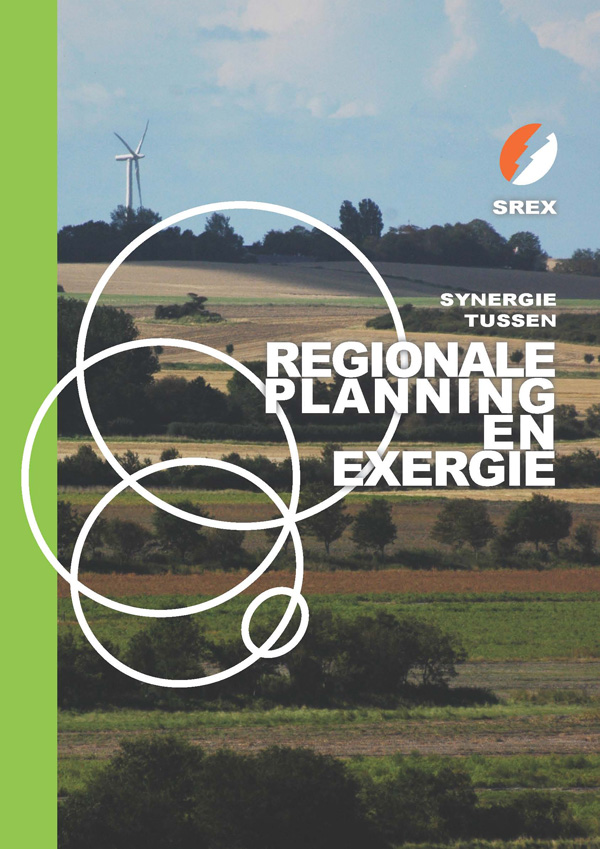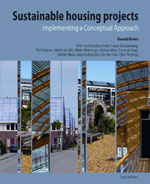
BOOKS reviewed


Of the books I read, some are highly readable or give enlighting views, others were disappointing or a waste of time.
I thought it might be useful to list them here with my findings as a help in selecting and finding a interesting books . If time available, I will give some kind of review, otherwise its just an indication, but of course you can judge for yourself.

Towards 0-impact buildings and built environments
Ronald Rovers et all.
The future will be about 0-energy buildings and built environments, but also 0-material and 0-water districts. A lesser ambition makes no sense in the light of current knowledge on our environmental situation. This book highlights the current insights on how to achieve a 0-impact situations, in new and existing districts . The book contains original contributions, key note speeches from the SB10 conference Western Europe (october 2010) as well as a selection of the best papers for that conference.

Regional Planning and Exergy
SREX research programme
editor: Andy van den Dobbelsteen
The book is the final publication of 4 years of research into the consequences of optimising spatial planning from exergy analyses perspective. Both in rural and urban areas , exergy consequences are analysed, as well as the potential chains of energyconversions. The book is in Dutch, but many publication papers and presentations are available in english (the research produced 3 PhD's), see the projects website , which is also the place to order the book.
Ttwo chapters are available in english on this website, see the theory pages.

Sustainable Housing Projects:
Implementing a Conceptual Approach
By Ronald Rovers & Dutch Expert Team
Sustainable Housing Projects takes a wide, conceptual approach for sustainably-built projects, which allows an integrated approach to the various stakes and stakeholders. Such an approach is particularly suitable for a medium scale level, involving neighbourhood development, and a number of examples on this scale level are included.
Sustainable Housing Projects presents knowledge gained over the last 15 years developing new sustainable housing projects in the Netherlands, by well known experts.
The Shock Doctrine , Naomi Klein 2007
if you are into sustainability, you deal with resources and closed cycles, and add people and social behavior in the mix, and as a last ingredient you try to make it fit within current economy. Which is a old fashioned and human invented system that most of the time works against sustainability. Which is what those who are a bit longer involved into sustainability experience, but cant grab, since we are no economy specialists. Well , read Noami Klein, and you know the problem. Forget what you are doing, it makes no sense, in the current economical climate. Its has been modeled for unlimited financial profit, and not for unlimited peoples social development, or optimal planets management . Read about the background of the south American revolutions, and how they were created and exploited for multinationals profits. No wonder many South American countries resist further interference in their economies. The best example provides Iraq. A useless war, for spooky chemical weapons. Within a few month after the invasion, 200 local companies where privatized, taken over by US companies, with mass dismissal of employees for efficiency improvements, and the capital was pulled out of the country. No wonder the local people turned against the US: as one employee words it , cited in the book: "Either we will set the factory on fire or we will blow up ourselves inside it. But it will not be privatized. " This is liberal capitalism. And it continues to proliferate. Did you know that Cheney and Rumsfeld were owners of several companies that were hired to support the US army in Iraq? Unbelievable, ministers having a financial interest in war industry…
And much more. You think you know it, but its much worse. Written by one of the most respected journalists in the field, reading the book is a shock in itself, and explains many frustrations people have that are into sustainability. Not that we can change it…. It has to collapse.
****
The world until yesterday , Jared Diamond 2013
Jared Diamond describes the life and habits in many tribes in New guinea, and some other parts of the world, and shows that there are other ways to deal with conflicts as in our industrialized society, as well as for instance barter trade. What I liked most is a comparison of death causes: none of the industrialized world causes is on the list of these tirbes… ( except in some case alcohol. ) No car accidents, guns, or motorcycles, In their case its mostly falling trees ( or falling out of trees), insect bites, and drowning. It makes you think. Very nice and interesting reading.
**
Why the West rules - for now, Ian Morris 2010
In our lives we know the well industrialized west, and wonder why China missed the industrial revolution until recently. All the more if you take a longer life span, say 4000 years, then China has had as much flowering periods as the " West, and was even in front of the West many periods. How come?
Morris tries to find an answer , by comparing East an d West following a definition of social development and 4 key indicators. It provides highly interesting insights the more since it links energy and social development directly. As he writes and defines:
This process of scrambling up the great chain of energy is the foundation of what , following the tradition of evolutionary anthropologists since Naroll in the 1950;s, I will call social development , basically, a groups ability to master its physical and intellectual environment to get things done.
Putting it more formally social development is the bundle of of technological , subsistence, organizational, and cultural accomplishments through which people feed, clothe, house, and reproduce themselves, explain the world around them, resolve disputes within their communities, extend their power at the expense of other communities, an defend themselves against others attempts to extend their power. Social development , we might say measures a community's ability to get things done, which in principle, can be compared across time and space. (Page 143)
The traits he uses to measure and compare east and west are : Energy capture, Urbanism, (organizational skills) information processing, and Capacity to make war ( access to resources). And the storey unfolds as a rough ride throughout history, in which many resemblances to the exergy of eco-systems can be recognized.( but that's my personal interpretation) . It ends with a extrapolation to the future, which I will not mentioning here to not spoil reading.
Though you can put question marks here and there, it's a brilliant analyses, and basis for understanding history and society, and if and how it can be sustained.
****
Hungry city, Carolyn Steel 2008
Already in 1939 someone called lady Eve Balfour experimented with two farms, one ecological the other chemical. The Chemical farm developed dependency on a chemical fix ( drug addiction), the other a natural balance, with peaking nutrients in growing season and yields as high or better as the chemical one.
So where did it change and go wrong? Did it go wrong? This is what Steel analyses in her book, with many interesting facts and figures. About pre industrial agriculture, city growth, the monsantos ( that develop terminator technology: seeds that on ly work once, built in destruction) . The relation between food ( hunger) and the city is more or less only detailed when it comes to people and densities, not so much into shaping the city itself. However she touches frequently upon issues realted to urban farming, and the potentials for it.
In the end she worries about the :"… sheer scale and complexity of the problems: urbanization, capitalism, geopolitics, peak oil, hunger global warming, - faced with a list like that where on earth does one start: It might strike us that there is something that does connect them all: (…) Food .
I think it's the land, and the ability to not only produce food but also energy and materials, which is ultimately the binding and limiting factor, ( and the competition between these, which is hardly touched upon) , but that might be for another book, . This one is about FOOD.
***
Architectuur als klimaatmachine ,(Dutch) Vera Yanovshtchinsky, et all 2012
Goed overzicht van de fysische aspecten van gebouwen, met vele voorbeelden technieken en achtergronden. De titel is echter misleidend, Architectuur, en de relatie met klimaat en milieu komt niet uit de verf. Net zo min als het effect van materialen door energiemaatregelen, dat bij 0-energiegebouwen het enige criterium wordt ( energie is dan geen probleem meer, wel de extreme inzet van materialen) . Er staat dan ook amper iets in over afwegingen en keuzes, het meten van effecten daarvan, en er is dan ook geen garantie dat dit tot verlaging van de milieubelasting leidt. Wat misschien geen wonder is, wanneer people als uitgangspunt wordt genomen, ipv planet. Maar met die afbakening, vele interessante onderwerpen. .
*
2013 and before added:
Our Urban future- State of the World World Watch Institute 2007
Its not about the overall vision on urban development, nor all research related to that. Its more a collection of essays, on specific topics, and mainly focusing on problems related to the developing world. Nothing wrong with that: a lot of information and insights are provided. The energizing cities chapter is a bit disappointing, , strengthening local economies is rather interesting.
**
Revolutie met Recht, (Dutch) Roger Cox 2011
(Revolution Justified : now available in English !
Is there an escape, will we be able to convince politicians to address climate change, peak oil and resource depletion? So far every expert I asked agreed that most likely we will face disasters, and will not be able to make gradual changes. Even democracy is under discussion , it has lost power to the multinationals. And then there is Roger Cox finding a way out! He describes the issues, analyses them and looks at these trough the juridical glasses and finds laws and legal ways to force nations to take measures. The judges are the only ones left that can objectively weigh the scientific evidence , regardless populist outcries or political short sightness . Brilliant analyses and more or less a prosecutors closing speech. Now lets get organized and make them move!
****
Critical Path, R. Buckminster Fuller 1981
Buckminster Fuller is often thought to be one of the first to warn about our resource use in construction , and to treat resources in a sustainable way. That's correct, but he does so by advocating increasing efficiency and application of all new technological inventions, so that more resources are available for mankind, and can be equally divided among the global population. And that was his main drive: a uplifted standard of living for all.
Nonetheless, his books are highly interesting since he chooses his own line of thinking, coming up with unique points of view and solutions. In this book he summarizes his knowledge of the past 50 years, and I just don't want to withhold you one of the examples he uses to fight the establishment :
" in 1933, 34, 35 and 36 the New Deal and the US diligently investigated the banking system, and the radices of its most powerful leaders, They found many malpractices, () More prominently they found the banks loaded with worthless mortgages on properties that were unsalable because uninhabitable-, mortgages on buildings without roofs, bathrooms etc. "
" Even today in the last 20 years of the twentieth century, people know little more about banks than they did during the 1929 crash or at the depth of the depression in 1932, when all they new was that they had lost their deposits in most of them."
Or : "Fortunately, the sun does not demand payment for all energy that it delivers by radiation to earth in the overall cosmic scheme which is trying to make humanity a success despite our overwhelming ignorance and fear …."
And he re-introduces "world game" (a strategy) , in which he: "demonstrates the capability , which can be fully realized within ten years, of producing and sustaining a higher standard of living for all humanity than that ever heretofore experienced or dreamt of by any."
This is not an option or a hope, its an engineeringly demonstrable fact This can be done using only the already proven technology and with the already mined , refined and im-recirculating Physical resources.
This will be an inherently sustainable Physical success for al humanity and all its generations to come. It can be accomplished not only within ten years, but with the phasing out forever of all use of fossil fuels and atomic energy. Our technical strategy , makes it incontrovertible that we can live luxuriously entirely on our daily Sun-radiation-and-gravity-produced income energy. World game makes it eminently clear that we have four billion billionaires on our planet as accounted by real wealth , which fact is obscured from public knowledge by the exclusively conceived and operated money game and its monopolized credit system accounting.…."
"World game comprehensively details that which individual humans must do to realize total success for all and do so within the critical time limit, before humanity passes the point on no return en route to self-extinction. You have to decide whether you want to make money or make sense, because the two are mutually exclusive."
Amazing….
**
Silent Spring Rachel Carson 1963
" In an age when man has forgotten his origins and is blind even to his most essential needs for survival, water along with other resources has become the victim of his indifference". Writes Carson in 1963…
As an introduction to one of the chapters.
Its unbelievable in how strong words she fights industry and malpractices of government and farmers, and with what immense amount of evidence collected. It's a massive piece of work. No wonder she succeeded in some way to abandon some chemistry, and launched a environmental movement.
I cant resist to quote the last sentences of the book:
" The control of nature is a phrase conceived in arrogance , born of the Neanderthal age of biology and philosophy, when it was supposed that nature exists for the convenience of man. The concepts and practices of applied entomology for the most part are from that Stone age of science. . Its our alarming misfortune that so primitive a science has armed itself with the most modern and terrible weapons , and that in turning them against the insects it has also turned them against the earth."
Have we already succeeded, in escaping our Neanderthal roots since then ? I am afraid not….
****
Sense and sustainbility / Leren van de natuur UK/Dutch, Ken Webster, Craig Johnson, 2010
Its a flaw of many of these kind of books: They recognize the need to work in closed cycles of resources, but try to establish this within the current social organization, , the thinking in products, and within contemporary economical assumptions. The issue is not to provide efficient products, but to provide functions in the best possible way. Not a cradle to cradle laundry machine is the issue, but how to clean laundry, that's the question. The future requires a different approach and value system, otherwise its doing the wrong thing a little bit less worse . Like the mantra : " it can be recycled afterwards!" But that's not the point, its pushing the problem to the future. The problem is the first time input of of energy and material resources! Like others this book is also full of these kind of halve truths, or vague defined assumptions. Like Masdar office being the first energy producing multifunctional building. That is already operating for years in Freiburg (Rolf Dish, Sonnenschiff). The Authors did not do their homework. Besides, they completely overlook the material impacts of all choices. In short, nice try, but not useful for education.
*
Surviving the century , Herbert Girardet and others,
World future Council 2007.
Interesting collection of essays on several issues , like renewable energy, urban developments, feeding the world.
**
Lila Robert Pirgis
Remember "Zen and the art of motorcycle maintenance" ? Pirgis could not come to a conclusion, and he struggled 20 years after or so to get his thoughts right. That's when he wrote Lila, and formulated an answer to the dilemma. It's written as a journey on a sailing boat, during which he clarifies his thoughts and develops a Metaphysical view and explanation , in which four levels of human evolution are analyzed . Brilliant thinking, Are we really up to a next level in evolution?
****
Collapse Jared Diamond
The Vikings , the Easter islanders, the Anasazi, the Greenlanders, and Maya's : What did they do and what happened to them? And most important what can we learn from them? Since they were small communities, living on a restricted area, like islands, but today we are with 7 billion, and the world is one big island, but still an island. Its about black holes : cities and communities that swallow goods but produce nothing. Trees cut , forests gone. Except for instance in Japan, during he EDO period: isolated from the rest of the world they developed a somewhat closed cycle approach tor resources and managed to do so. Until Americans came and forced them to open up borders in 1862. But that's another story.
A must read, and re-read.
****
Plan B , 4.0 Lester Brown 2009
Plan B is a plan to counteract our current unsustainable behavior. Its updated regularly, this is version 4.0 . This one has a outstanding analyses of land use and agriculture changes going on.
I learned many hidden effects, and astonishing facts about land grabbing by countries. If you have dust on your car, somewhere in the world food production is in danger…
And carpets require sheep that degrade the land, make it erode, creating dust storms , with disappearing villages as a results ( the Iran Afghanistan area) .You don't see it in your local shop, but all these effects are inclusive in your buy. Not to speak about the devastating effect of palm oil for car fuel.
See also: http://farmlandgrab.org/
The second part , on plan B itself is a bit disappointing. It's a pitty that LEED gets such a prominent place in tackling the built environment, as an instrument of the industry itself. And more too easy so called wins are described. But if you stay critical while reading, a noteworthy book .
**
Nieuwe energie (Dutch) Anne-Marie Rakhorst 2010
Populistische beschrijving en onbeschaamd lenen van ideeën en teksten van anderen, om eigen profilering te onderbouwen. Vrijwel uitsluitend aandacht voor nieuwbouw bijvoorbeeld , terwijl bestaande bouw het feitelijk op te lossen probleem is, en wie Calatrava als voorbeeld gebruikt heeft het niet begrepen, de grootste verkwister in materiaalgebruik onder de architecten, soms to 5 x zoveel als gebruikelijk, geen wonder dat zijn rekeningen ook tot 5 x zo hoog worden… Subkopjes als "Waterstof als brandstof" (?) oa en "met c2c valt geld te verdienen"… Dat was niet de bedoeling: de bedoeling is milieubelasting te verlagen….? Het boek is feitelijk deel van het probleem.
-
When the rivers run dry Fred Pearce
One of the best books of Fred Pearce, the probably best informed person in the world, seeing his massive production and the amount of people interviewed for his deep digging books. This one opens up the world of water management, and the picture is shocking: How we mess up our waterworld, and keep continuing….
****
6 degrees Mark Lynas 2007
Mark Lynas explores the consequences of each degree increase in average temperature. During the hot summer in 2033 the average was 2,3 degrees higher in Europe. It showed the consequence of a permanent " 2-degree-world" : 10.000 dead in Paris alone, overheated, a regular phenomenon to see in in the two degree world. The 6 degree will be like Hell….
**
Surviving the century Herbert Girardet and others, World future Council 2007.
Interesting collection of essays on several issues , like renewable energy, urban developments, feeding the world.
**
The Last generation Fred Pearce 2006
Fred Pearce looks at the latest results of science, which are far more threatening as the formal IPCC reports show. The signs are that changes will increase in speed, and that sudden changes will take place. When and where is unknown. The conveyor belt, the Greenland ice sheet, etc etc, they all have critical paths, and the signs are not good at all. It's a great written book, with very good research and science basics, Which should set all alarm bells to ring. Since , As Pearce writes: In the past we could pick up our things and go somewhere else. Nowadays we are stuck. We have only one atmosphere, one planet.
Indeed, and that's an island….
***
Duurzaam Denken Duurzaam Doen (Dutch) 2011-2035 diverse auteurs 2011
Teleurstellend. Verwachtte er veel van maar kwam op de koffie: zeer oppervlakkige verzameling algemeenheden en extrapolaties van bekende (al dan niet goede) aanpakken van nu naar 2035, maar geen grondige analyse en/of doorwrochte visie.
-
Storms of my Grandchildren James Hanssen, 2010
explaining climate science, feedbacks, enforcements and latest research findings , packed in a story of policies frustrating action. Personalasized review of of 20 years in climate research, and written so his grandchildren could not say: Granddad knew, but did not speak up. Very readable, and some too technical parts can be skipped.
****
Eco-Exergy and sustainability Sven Erik Jorgensen, 2009
combining pure Physics of exergy with ecosystems performance, leading to a absolute evaluation of sustainabiliy. Very interesting reading but only for the expert.
*** (strong physical reading)
Basisboek Duurzame ontwikkeling (Dutch) Niko Roorda 2009, (2011 besteld)
Wel aardige voorbeelden, maar dringt zelden tot de kern door. Aardige verzameling verwijzingen tabellen etc, maar legt niet de echte verbanden. Vooral sociaal en economisch gericht, maar niet op de bron van alle ellende; de bronnen. Geen leerboek voor duurzame ontwikkeling in ieder geval, wat duurzaamheid is 9 volgens auteur) wordt niet duidelijk of blijft onevenwichtig.
Niet gebruiken als leerboek, maar voor docenten aardige voorbeelden uit te halen.
*
The Upside of Down -Ten Onder te Boven (English and Dutch versions) Thomas Homer-Dixon 2006
Great book, one of the best of the past years. It makes connections between problems and tensions in society ( population, energy, environment, climate and economy) , analyses and draws lessons from history, explores routes of solutions, very comprehensive and well funded. Highly readable and inspriring, recommended!
****
Klima Kriege / Klimaat oorlogen /Climate Wars (German, Dutch, English) Harald Welzer 2008
Interesting book, and the threat of wars is not unthinkable, seeing he massive problems ahead of us. Although at the end of the book, one is not convinced of the arguments brought forward. It feels incomplete.
*
The Climate files Fred Pearce 2010
Interesting background with the leaking emails last year from the IPCC involved climate researchers. Good picture behind the scenes, how science works, and interestingly showing how climate sceptics try to undermine science, almost always supported from dubious sources.
**
People Quacke / Volksbeving (English / Dutch) Fred Pearce 2010
Very elaborate description of population trends, and related impacts. A massive body of information, and good insight in the real trends: The population bomb is already being diffused, although we will not notice before 2050, on a global scale that is. Already now more then 50 % of women have max 2 children average.
***
4000 jaar kringloop landbouw (Dutch) Sietz Leeflang, 2010
Sietz Leeflang (de 12 Ambachten) heeft al tientallen jaren betoogd en gedemonstreerd dat het anders kan en moet, en vooral met landbouw. Het gaat er steeds meer naar uitzien dat hij gelijk krijgt. Afgelopen jaar heeft hij een boek vertaal dat begin 19e eeuw is geschreven nav een reis langs de toen gangbare chinese en japanse landbouw. Die 4000 jaar overeind bleef met dezelfde opbrengsten, en zonder nadelige effecten. Een perfecte kringloop derhalve, en een voorbeeld voor de toekomst, wellicht in een modern jasje. Zeer interessant, en met vele nuttige toelichtingen. Helaas zijn de Chinezen zelf die aanpak ook aan het vergeten.
***
Guns germs and steel Jared Diamond
We settled some 10.000 years ago, and we managed somewhat to leave the hunter and gatherer stadium behind us since then. But not all at the same time, and with different crops and domesticated animals? And why? How did we manage to feed our self, and why horses are domesticated, but lamas hardly? If you ever want to know about how come that you live there and I live here, and what brought us here and there, read this book, it shows you why we ended up where we are. (Still being hunters and gatherers though, of fossil fuels and resources, but that's another story…)
***
Something new under the sun J.R.Mc Neill 2000, revised 2008
an environmental history of the 20th century
It was the book back then ( 2000) that opened my eyes for a wider energy and exergy evaluation of the world, as mcNeill showed convincingly that slavery in 17 and 18 th century was in fact the first energy crises: The slaves produced more then they energy wise consumed. And the Dutch already back then were the merchants, that did not get their hands dirt with slavery but with trading them. And became so rich that they could buy the slave' s production again. No wonder the Netherlands was the first country with more as 10% of people living in cities.
There is a revised version(2008), which even more puts the finger on the weak spots in cultures and countries,, and the consequences and stupidities in our system.
****
cadillac desert Marc Reisner, 1986
The american west and its disappearing water,
A classic when it comes to water management, a must read if you want to learn about how things can go wrong, technically, physically and politically. It was already in 1986 that this book was published, and it seems not much was learned. In parts its really shocking, like how the US can't let river water just run into Mexico, but have to desalinize it first. One of the best documented books I have read, and readable as well.
****
Terra reversa (Dutch only) Peter Tom Jones & Vicky De Meyere
Boek over de transitie naar rechtvaardige duurzaamheid. uitgaande van de mens.
Goed overzicht van de veranderingen die in de samenleving nodig zijn, en een introductie in de transitie theorie, die dergelijke ingrijpende veranderingen kan begeleiden en sturen. Per thema, transport , wonen, wordt dan een verdieping gegeven, aan de hand van Vlaamse en Nederlandse voorbeelden. Zonder meer de moeite waard, maar de vraag blijft of de mensen zelf in staat zullen zijn die veranderingen ook in gang te zetten, of dat de natuur ons een handje gaat helpen, of zelfs inhaalt. Maar transitie aanpak is de enige hoop.
**
Cradle to Cradle M.Braungart and W.McDonough 2002
Cradle to Cradle brings together the knowledge and experiences of the past decades, in moving from cradle to grave to cradle again. How to develop products not less bad, but in a good way. Very inspiring, and certainly very valuable in designing products. But that's the main critics: Cradle to cradle is still mainly about products and production. Its somehow similar to whats happening in food: back to basics and slow food. However with the same restriction: the latter does not solve hunger, the other not resource scarcity. The boundaries of any system are neglected, and depletion or land constraints trivialized.
**
The Revenge of Gaia Amory Lovins
Disappointing follow up of the first book of Lovins: Gaia. The first book provided a interesting thought and opened up the mind for a broader and new insights. In this book he tries to prove his theory, and shows paths of solutions, but misses the key points many times, and lacks knowledge of recent research and insights in many issues. Forget it.
-
**** must read ; *** very interesting ; ** provides insights / background ; * ok, but read critically ; - save your time
BOOKS to buy





Sustainable Building Support & consultancy
Ronald Rovers email: r.rovers<at>sustainablebuilding.info






